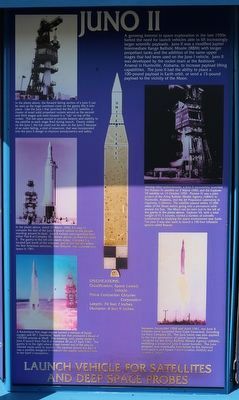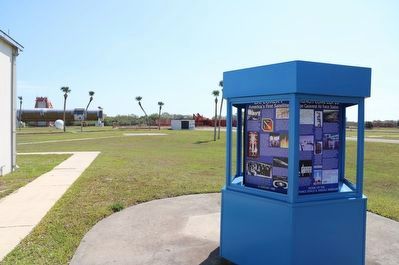Cape Canaveral in Brevard County, Florida — The American South (South Atlantic)
Juno II
Launch Vehicle for Satellites and Deep Space Probes
A growing interest in space exploration in the late 1950s fueled the need for launch vehicles able to lift increasingly larger scientific payloads. Juno II was a modified Jupiter Intermediate Range Ballistic Missile (IRBM) with longer propellant tanks and the addition of the same upper stages that had been used on the Juno I vehicle. Juno II was developed by the rocket team at the Redstone Arsenal in Huntsville, Alabama, to increase payload lifting capabilities. The Juno II had the ability to place a 100-pound payload in Earth orbit, or send a 15-pound payload to the vicinity of the Moon.
(captions)
In the photo above, the forward fairing section of a Juno II can be seen as the huge overhead crane on the gantry lifts it into place. Like the Juno I that launched the first U.S. satellite, a cluster of small solid propellant rockets served as the second and third stages and were housed in a "tub" on top of the rocket. This tub spun around to provide balance and stability to the satellite as each stage fired during launch. Clearly visible on the Juno I, the tub could not be seen on the Juno II because of an outer fairing, a kind of nosecone, that was incorporated into the Juno II design to improve aerodynamics and safety.
In the photo above, dated 23 March 1960, it’s easy to compare the size of the Juno II launch vehicle to the people standing around its base. Juno II rockets were launched from either Pad-B at Complex 26, (shown above), or from Complex 5. The gantry to the left still stands today. Complex 5 is located just south of the museum, and is also the site where the first American astronaut, Alan Shepard, was launched into space in 1961.
Specifications:
Classification: Space Launch Vehicle
Prime Contractor: Chrysler Corporation
Length: 76 feet 7 inches
Diameter 8 feet 9 inches
A Rocketdyne first stage engine burned a mixture of liquid oxygen and RP-1 (kerosene) liquid fuel that produced a thrust of 150,000 pounds at liftoff. This stunning color photo shows a Juno II launch from Pad-B at Complex 26 on 27 April 1961. The gantry is to the right where it was moved out of the way on railroad tracks prior to launch. The payload aboard this Juno II was a satellite designed ot measure the cosmic radiation levels in the Earth’s ionosphere.
Among other achievements, a Juno II successfully launched the Pioneer IV satellite on 3 March 1959, and the Explorer VII satellite on 13 October 1959. Pioneer IV was a joint project of the Army Ballistic Missile Agency (ABMA) in Huntsville, Alabama, and the Jet Propulsion Laboratory in Pasadena, California. The satellite passed within 37,000 miles of the Moon before going into a permanent orbit around the Sun. The Moon can been seen just to the left of the gantry in the photo above. Explorer VII, with a total weight of 91.5 pounds, carried a number of scientific instruments for studying the space environment near Earth. The Juno II was also used to launch a 100-foot inflatable sphere called Beacon.
Between December 1958 and April 1961, ten Juno II vehicles were launched from Cape Canaveral, including six from Complex 26. The Juno names was also applied to the next generation of space launch vehicles designed by the Army Ballistic Missile Agency (ABMA), including a proposed Juno V super booster. The Juno program was eventually transferred to the National Aeronautics and Space Administration (NASA) and renamed Saturn.
Erected by Cape Canaveral Space Force Museum.
Topics. This historical marker is listed in these topic lists: Air & Space • Exploration • Science & Medicine. A significant historical date for this entry is March 3, 1959.
Location. 28° 26.637′ N, 80° 34.326′ W. Marker is in Cape Canaveral, Florida, in Brevard County. Marker is on Museum Circle south of Lighthouse Road, on the left when traveling south. Touch for map. Marker is at or near this postal address: 191 Museum Cir, Cape Canaveral FL 32920, United States of America. Touch for directions.
Other nearby markers. At least 8 other markers are within walking distance of this marker. Redstone (here, next to this marker); Jupiter (here, next to this marker); Launch Complex 26 (here, next to this marker); Explorer I (here, next to this marker); a different marker also named Launch Complex 26 (a few steps from this marker); a different marker also named Launch Complex 26 (within shouting distance of this marker); a different marker also named Launch Complex 26 (within shouting distance of this marker); First United States Space Launch (within shouting distance of this marker). Touch for a list and map of all markers in Cape Canaveral.
Also see . . . Cape Canaveral Space Force Museum. (Submitted on March 8, 2023.)
Credits. This page was last revised on March 8, 2023. It was originally submitted on March 8, 2023, by Dave W of Co, Colorado. This page has been viewed 78 times since then and 17 times this year. Photos: 1, 2. submitted on March 8, 2023, by Dave W of Co, Colorado. • Bernard Fisher was the editor who published this page.

